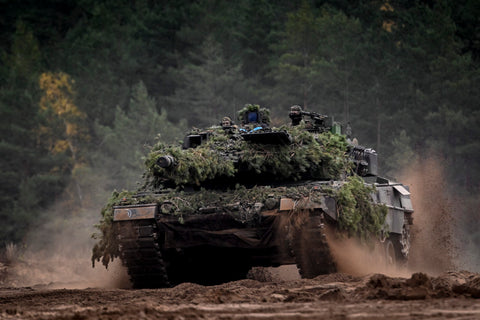
The Gepard Tank: A German Leopard That Changed its Spots in Ukraine
During World War I an American pilot is alleged to have confessed, “I’m not worried about the bullet with my name on it; it’s the one marked ‘To whom it may concern’ that scares me.” He was comparing German aircraft to anti- aircraft fire from the ground. In World War II, the Germans earned an even more formidable reputation for its wide variety of stationary and mobile anti- aircraft artillery, from quadruple 20 mm cannons to 105 mm Flugabwehr Kanone, now universally known by its acronym, flak.
In the Cold War years, the revived Bundeswehr __ (Federal Armed Forces) acquired a new generation of weaponry for countering the Warsaw Pact, including an anti-aircraft artillery (AAA) system that may have been developed in the 1960s, but is still considered the best weapon of its kind. Good enough to be entering combat again by the Ukrainian army against the “special military operation” that Russia launched into its territory on February 24, 2022.
Cold War Defender
In December 1965, the first Porsche-produced Leopard main battle tanks (MBTs), armed with German-made, British developed L7 105 mm cannons, was ordered for the Bundeswehr and was soon appearing in other forces of the North Atlantic Treaty Organization. It proved superior to its NATO contemporaries and soon Kraus-Maffei Wegmann (KMW) started work on a mobile AAA vehicle — based on the Leopard’s torsion bar suspension chassis — to accompany it into the field and defend the MBT from air attack.
Called the Gepard (cheetah), it replaced the tank turret with two 73 mm Oerlikon KD automatic cannons on a two-man, quick-turn turret with radar direction, each capable of firing 550 rounds per minute at a maximum effective range of up to 5,500 kilometers. These were supplemented by four 76 mm smoke dischargers, two on either turret side. Although armor protection was reduced, it could still stop a 14.5 mm round and the vehicle’s interior offered nuclear biological and chemical protection to the three-man crew.
The Gepard could carry up to 310 of a variety of anti-aircraft rounds, including AHEAD (advanced hit efficiency and destruction) programmable ammunition, plus 20 APDS-T anti-tank rounds for engaging ground targets. With a length of 25 feet, 2 inches, a width of 12 feet, 2 inches and a height of 10 feet, 10 inches with the radar retracted, the 47.5-ton Gepard was powered by an 819-hp 10-cylinder MTU multi-fuel engine that gave it a maximum speed of 40 mph and a range of 340 miles.
In September 1973 Kraus-Maffei got a 1.2-billion Deutschmark contract for 432 turrets for the Bundeswehr, for which they entered service in December 1976, as well as 55 units for Belgium and 95 for the Netherlands. In field use, the Gepard proved to be as good against ground attack warplanes as the Leopard was against tanks.
A Relic of the Past Gets New Life
If the Gepard system had a weakness, it was characteristic of sophisticated, finely engineered weaponry, costing three times to produce as a Leopard tank. As lighter, less expensive anti-aircraft weapons proliferated, the Bundeswehr began replacing its Gepards with Wiesel 2 light anti-aircraft vehicles in 2010. That was not to say that the Germans relegated their Gepards to the scrap heap of Cold War history, however, and on April 26, 2022, they delivered the first three of an eventual 50 help Ukraine counter the Russian invasion.
One snag turned up in the process when testing revealed that the 50,000 rounds to be donated by Norway were incompatible and unable to be fired from the 35 mm guns. Modifications corrected the problem and as of July 25 Der Spiegel reported that the first three Gepards were entering Ukrainian front-line service.
Few as the first Gepards were, they soon made their presence known. On Sept. 26 they were reportedly supporting the Ukrainian counteroffensive, operating alongside stocks of Soviet-made 9A33BM3 Osa anti-aircraft rocket launchers (NATO codename SA-8 Gecko), which would engage Russian aircraft as far as nine miles away or eight miles high, while the Gepards provided the backup against any attack planes got past the missiles.
On Oct. 18 the Ukrainians claimed that one of their Gepards shot down a Russian Kh-101 cruise missile targeting Kyiv. As of Nov. 19, 30 Gepards operational and that they were providing a cheaper alternative to anti- aircraft guided missiles against the latest threat, as explained by a Ukrainian embassy official: “Gepard has become an effective weapon against Iranian Shahed-136 drones.”
By late November reports suggested that the Russians were running low on the Shahed drones, which had been expended in large numbers against civilian targets, with most falling short of their goals, increasingly the victims of Ukraine’s newest and most effective AAA system.
historynet magazines
Our 9 best-selling history titles feature in-depth storytelling and iconic imagery to engage and inform on the people, the wars, and the events that shaped America and the world.
